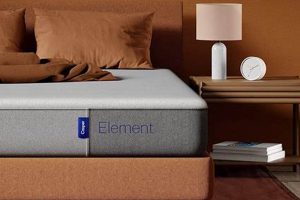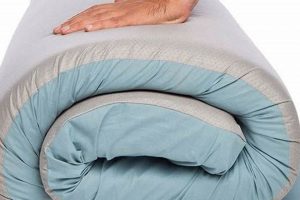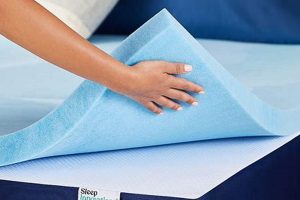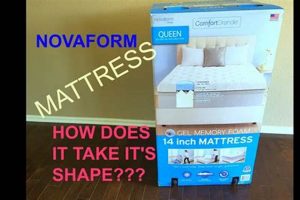The act of utilizing an inflatable sleeping surface is common in temporary lodging situations. These surfaces, typically constructed from polyvinyl chloride or similar flexible polymers, are filled with air to provide a cushioned platform for rest. Examples of usage include camping, accommodating overnight guests, or as a temporary bed solution during relocation or home renovation.
The appeal of this sleeping arrangement lies in its portability, ease of storage, and affordability. Historically, such solutions offered a more comfortable alternative to sleeping directly on the ground or on rudimentary bedding. Modern iterations often incorporate features like built-in pumps for automated inflation and deflation, as well as flocked surfaces to enhance comfort and prevent bedding from slipping. This contributes to their practicality in diverse settings.
The following sections will delve into considerations regarding the suitability of this type of sleeping arrangement, encompassing factors such as comfort, support, durability, and potential health implications. Furthermore, different types of inflatable surfaces and best practices for their use will be discussed.
Optimizing Inflatable Sleeping Surfaces
Maximizing comfort and longevity when employing an inflatable sleeping surface requires adherence to specific guidelines. These recommendations aim to enhance the user experience and prolong the lifespan of the product.
Tip 1: Surface Preparation: Prior to inflation, ensure the underlying surface is free from sharp objects and debris. A protective layer, such as a blanket or tarp, can mitigate the risk of punctures and abrasions.
Tip 2: Inflation Management: Avoid overinflation. Excessive pressure can compromise the structural integrity of the material, leading to seam failure or bursting. Refer to the manufacturer’s instructions for optimal inflation levels.
Tip 3: Temperature Considerations: Ambient temperature fluctuations can affect air pressure within the mattress. Monitor and adjust inflation levels as needed to maintain consistent firmness. Colder temperatures will cause the air to contract, requiring additional inflation.
Tip 4: Weight Distribution: Distribute weight evenly across the surface. Concentrated pressure in one area can strain the seams and reduce overall support. Consider the weight capacity specified by the manufacturer.
Tip 5: Proper Bedding: Utilize appropriate bedding to enhance comfort and insulation. A fitted sheet and additional blankets or a sleeping bag can improve thermal regulation and prevent direct contact with the mattress surface.
Tip 6: Storage Practices: When not in use, deflate the mattress completely and store it in a cool, dry location away from direct sunlight and extreme temperatures. Proper storage minimizes the risk of material degradation and prolongs the product’s usability.
Tip 7: Regular Inspection: Periodically inspect the mattress for signs of wear and tear, such as leaks, punctures, or seam separation. Addressing minor issues promptly can prevent more significant problems from developing.
By implementing these guidelines, users can significantly improve the experience associated with temporary inflatable sleeping surfaces, enhancing both comfort and product lifespan.
The subsequent sections will address specific product types and potential health considerations related to using inflatable sleeping solutions.
1. Portability
Portability is a defining characteristic of inflatable sleeping surfaces, significantly influencing their utility and application in diverse contexts. This attribute stems from their ability to be deflated and compressed into a fraction of their inflated size, facilitating ease of transport and storage.
- Compact Storage
When deflated, an inflatable mattress occupies minimal space. This is particularly advantageous in situations where storage capacity is limited, such as apartments, vehicles during travel, or camping gear. The ability to store the mattress in a small bag or container contributes to its overall convenience.
- Lightweight Design
Inflatable mattresses are typically constructed from lightweight materials, primarily PVC or similar polymers. This reduces the burden during transport, making them suitable for activities like backpacking or situations where minimizing weight is crucial, such as disaster relief efforts where bedding needs to be moved quickly.
- Ease of Transportation
The combination of compact storage and lightweight design allows for effortless transportation. Whether carried by hand, packed in a vehicle, or shipped via mail, the logistical demands are considerably less than those associated with traditional mattresses or cots. This adaptability renders them valuable in scenarios requiring mobility.
- Versatile Application
Portability expands the range of potential applications for inflatable mattresses. From providing temporary bedding for guests in small homes to offering a comfortable sleeping surface during outdoor adventures, their adaptability is a key benefit. This versatility caters to a wide spectrum of needs and preferences.
The inherent portability of inflatable sleeping surfaces directly contributes to their widespread use as a practical and convenient bedding solution. This characteristic distinguishes them from more cumbersome alternatives and underscores their value in situations demanding flexibility and ease of transport.
2. Support limitations
The degree of postural support offered by an inflatable sleeping surface is a critical factor determining its suitability for prolonged or regular use. The inherent design characteristics of these mattresses introduce specific limitations that users must consider, particularly in relation to spinal alignment and pressure distribution.
- Non-uniform Air Distribution
Inflatable mattresses, by their nature, rely on air pressure for support. However, achieving uniform air distribution across the entire surface can be challenging. Variations in air pressure can lead to inconsistent support, potentially causing localized pressure points and compromising spinal alignment. This can be particularly problematic for individuals with pre-existing back conditions.
- Lack of Contouring
Unlike traditional mattresses that conform to the body’s contours, inflatable mattresses offer limited contouring. This lack of precise body molding can result in inadequate support for the lumbar region and other areas requiring targeted support. Over time, this deficiency can contribute to discomfort and exacerbate existing musculoskeletal issues.
- Edge Support Deficiency
The edges of inflatable mattresses often exhibit diminished support compared to the central areas. This can pose a problem for individuals who tend to sleep near the edge or who require assistance when getting in and out of bed. The lack of stable edge support can increase the risk of falls and reduce the overall usable surface area of the mattress.
- Dependence on Inflation Level
The level of support provided by an inflatable mattress is directly correlated to its inflation level. Underinflation can lead to a sagging surface, providing minimal support and potentially exacerbating postural problems. Conversely, overinflation can create an excessively firm surface, increasing pressure points and reducing overall comfort. Maintaining an optimal inflation level is crucial, but even then, inherent support limitations persist.
These support limitations necessitate careful evaluation when considering inflatable mattresses as a sleeping solution, especially for extended periods or for individuals with specific physical needs. While advancements in design and materials may mitigate some of these concerns, the fundamental characteristics of inflatable structures impose inherent constraints on the degree of postural support they can provide.
3. Temperature sensitivity
The thermal behavior of inflatable sleeping surfaces significantly influences user comfort. The materials and air-filled structure inherent in these mattresses render them susceptible to fluctuations in ambient temperature, necessitating consideration of these factors for optimal sleep quality.
- Air Volume Expansion and Contraction
Air, the primary filling medium, expands with increasing temperature and contracts with decreasing temperature. This physical property directly affects the firmness and support of the mattress. In warmer environments, the mattress may become overinflated and uncomfortably firm. Conversely, in cooler environments, the mattress may lose pressure and provide inadequate support. Regular adjustments to inflation levels may be required to compensate for these thermal effects.
- Material Heat Conductivity
The materials used in inflatable mattresses, typically PVC or similar polymers, exhibit limited thermal insulation properties. These materials conduct heat relatively easily, resulting in heat loss to the surrounding environment when the ambient temperature is low. This can lead to a cold sleeping surface, necessitating the use of insulating bedding to maintain warmth. In warmer conditions, the material can absorb and retain heat, potentially causing discomfort.
- Impact on Sleep Comfort
Significant temperature fluctuations can disrupt sleep. A mattress that becomes too firm or too soft due to temperature changes can compromise spinal alignment and pressure distribution, leading to discomfort and restlessness. Similarly, a sleeping surface that is too cold or too warm can interfere with the body’s natural temperature regulation processes, disrupting sleep cycles.
- Environmental Considerations
The impact of temperature sensitivity is particularly pronounced in outdoor environments, such as camping. Wide temperature swings between day and night can significantly affect the performance and comfort of an inflatable mattress. Strategic placement of the mattress, the use of insulating ground pads, and appropriate bedding choices can mitigate these effects and improve the overall sleeping experience.
The sensitivity of inflatable mattresses to temperature necessitates proactive management to maintain a comfortable sleeping environment. Understanding the underlying physical principles and employing appropriate strategies to counter thermal effects are essential for optimizing the user experience, particularly in environments where ambient temperature varies significantly.
4. Durability concerns
The longevity and resilience of inflatable sleeping surfaces are critical considerations, significantly impacting their overall value and suitability for intended use. Several factors contribute to potential durability issues, requiring careful assessment and proactive management to maximize product lifespan.
- Material Vulnerability
Inflatable mattresses are typically constructed from PVC or similar polymeric materials, which, while flexible and relatively lightweight, are susceptible to punctures, abrasions, and tears. Sharp objects, rough surfaces, and improper handling can compromise the integrity of the material, leading to air leaks and rendering the mattress unusable. This vulnerability necessitates careful handling and storage practices.
- Seam Integrity
The seams connecting different sections of an inflatable mattress represent a potential weak point. Repeated inflation and deflation cycles, coupled with pressure exerted during use, can stress the seams, leading to separation or failure. Manufacturing quality and the type of seam construction significantly influence seam integrity. High-quality mattresses employ reinforced seams to enhance durability.
- Environmental Degradation
Exposure to environmental factors, such as ultraviolet radiation, extreme temperatures, and humidity, can accelerate material degradation. UV radiation can cause the PVC to become brittle and prone to cracking. Extreme temperatures can affect the elasticity and strength of the material. Humidity can promote the growth of mold and mildew, which can further weaken the mattress. Proper storage in a cool, dry, and dark environment can mitigate these effects.
- Pump and Valve Reliability
Many inflatable mattresses incorporate built-in pumps or valves for inflation and deflation. The reliability of these components is crucial for the proper functioning of the mattress. Malfunctioning pumps or leaking valves can compromise the ability to inflate and maintain air pressure, rendering the mattress ineffective. Regular maintenance and adherence to manufacturer’s instructions are essential for ensuring pump and valve reliability.
These durability concerns underscore the importance of selecting inflatable sleeping surfaces from reputable manufacturers, employing proper usage and storage practices, and conducting regular inspections for signs of wear and tear. Addressing minor issues promptly can prevent more significant problems from developing, extending the lifespan of the mattress and maximizing its value.
5. Inflation consistency
Maintaining consistent inflation in an inflatable sleeping surface is paramount to achieving adequate support and a comfortable sleeping experience. Deviations from the optimal inflation level, whether due to leaks, temperature fluctuations, or pump malfunctions, directly impact the mattress’s ability to provide proper spinal alignment and pressure distribution. An underinflated mattress offers inadequate support, potentially leading to back pain and discomfort, while an overinflated mattress may become excessively firm, increasing pressure points and reducing overall comfort. The ability to consistently maintain the appropriate air pressure is therefore a critical performance characteristic.
The practical significance of inflation consistency becomes evident in various scenarios. For example, during extended camping trips, temperature fluctuations can cause noticeable changes in air pressure, necessitating periodic adjustments. Similarly, slow leaks, often imperceptible initially, can gradually reduce the mattress’s firmness over the course of a night, impacting sleep quality. Products with built-in pumps and pressure sensors that automatically maintain the desired inflation level offer a significant advantage in these situations. Moreover, the type of valve used and its seal quality directly affect air retention, with more robust valves minimizing the risk of leaks and contributing to greater inflation consistency. The effectiveness of inflatable sleeping surfaces as a temporary or portable bedding solution hinges on the ability to reliably maintain the desired level of firmness.
In summary, inflation consistency is a core attribute of inflatable sleeping surfaces, directly influencing support, comfort, and overall user satisfaction. The challenges associated with maintaining consistent air pressure highlight the importance of selecting high-quality products with reliable inflation systems and durable materials. Understanding the factors that affect inflation consistency allows users to make informed decisions and proactively manage their inflatable mattress to optimize the sleeping experience.
6. Storage implications
The storage requirements associated with inflatable sleeping surfaces significantly impact their practicality and long-term utility. The ease and efficiency with which these mattresses can be stored when not in use are key factors influencing their appeal and suitability for various applications.
- Deflation and Compression
The primary advantage of inflatable mattresses lies in their ability to be deflated and compressed into a significantly smaller volume than traditional mattresses. This deflation process allows for storage in compact spaces, such as closets, storage bins, or vehicle compartments. Proper deflation techniques, including the complete removal of air, are crucial for minimizing storage space and preventing material damage.
- Material Degradation during Storage
Improper storage conditions can contribute to material degradation and reduce the lifespan of an inflatable mattress. Exposure to extreme temperatures, direct sunlight, and moisture can compromise the structural integrity of the PVC or other polymeric materials used in their construction. Storing the mattress in a cool, dry, and dark environment is essential for preventing premature wear and tear.
- Protection from Punctures and Abrasions
During storage, inflatable mattresses are vulnerable to punctures and abrasions from sharp objects or rough surfaces. Proper packaging, such as storing the mattress in its original bag or a protective container, is crucial for preventing damage. Ensuring the storage area is free from potential hazards is also essential for maintaining the mattress’s integrity.
- Long-Term Storage Considerations
For extended periods of storage, it is advisable to periodically inflate the mattress to prevent the material from becoming permanently creased or folded. This practice helps maintain the elasticity of the PVC and prevents the formation of weak spots. Additionally, inspecting the mattress for signs of leaks or damage before each use is recommended to ensure its proper functioning.
In conclusion, the storage implications associated with inflatable sleeping surfaces extend beyond simple space efficiency. They encompass considerations related to material preservation, protection from damage, and maintenance of structural integrity. Adhering to proper storage practices is essential for maximizing the lifespan and usability of these mattresses, ensuring they remain a convenient and reliable bedding solution.
Frequently Asked Questions
This section addresses common inquiries and concerns regarding the use of inflatable sleeping surfaces. The information presented aims to provide clarity and facilitate informed decision-making.
Question 1: Are inflatable mattresses suitable for everyday use?
Inflatable mattresses are generally not recommended for long-term, everyday use. Their support limitations and susceptibility to temperature fluctuations can compromise sleep quality and potentially contribute to musculoskeletal issues. Traditional mattresses offer superior support and durability for regular use.
Question 2: How can the risk of punctures be minimized when sleeping on an inflatable mattress?
To minimize the risk of punctures, ensure the underlying surface is free from sharp objects and debris. A protective layer, such as a blanket or tarp, should be placed between the mattress and the floor. Avoid placing the mattress near objects that could potentially puncture the material.
Question 3: What is the optimal inflation level for an inflatable mattress?
The optimal inflation level varies depending on the mattress design and user preference. However, generally, the mattress should be inflated to a firmness that provides adequate support without being excessively firm. Refer to the manufacturer’s instructions for specific guidance.
Question 4: Can inflatable mattresses cause back pain?
Inflatable mattresses can contribute to back pain, particularly if they lack adequate support or are not inflated to the appropriate level. Individuals with pre-existing back conditions should exercise caution when using inflatable mattresses and consider alternative bedding solutions.
Question 5: How should an inflatable mattress be cleaned?
To clean an inflatable mattress, use a mild soap and water solution. Avoid harsh chemicals or abrasive cleaners, as they can damage the material. Wipe the mattress with a damp cloth and allow it to air dry completely before storing.
Question 6: What is the typical lifespan of an inflatable mattress?
The lifespan of an inflatable mattress varies depending on usage frequency, storage conditions, and material quality. With proper care and maintenance, a high-quality inflatable mattress can last for several years. However, frequent use and improper storage can significantly reduce its lifespan.
Inflatable sleeping surfaces offer a convenient and portable bedding solution for temporary use. However, understanding their limitations and adhering to proper usage and storage practices are crucial for maximizing their lifespan and ensuring a comfortable sleeping experience.
The subsequent section will explore alternative bedding options and their suitability for different scenarios.
Conclusion
The preceding analysis has examined various facets of utilizing an inflatable sleeping surface. Considerations ranging from portability and support limitations to temperature sensitivity and durability concerns have been detailed. The suitability of this option varies significantly based on individual needs, frequency of use, and environmental conditions. Factors such as inflation consistency and appropriate storage practices are critical in maximizing the lifespan and utility of the product.
While inflatable mattresses offer advantages in specific temporary situations, a thorough understanding of their inherent limitations is essential for informed decision-making. Further research into alternative bedding solutions and a careful evaluation of individual requirements are recommended before committing to this option. The information presented herein serves as a foundation for future investigations and responsible utilization of inflatable sleeping technologies.







